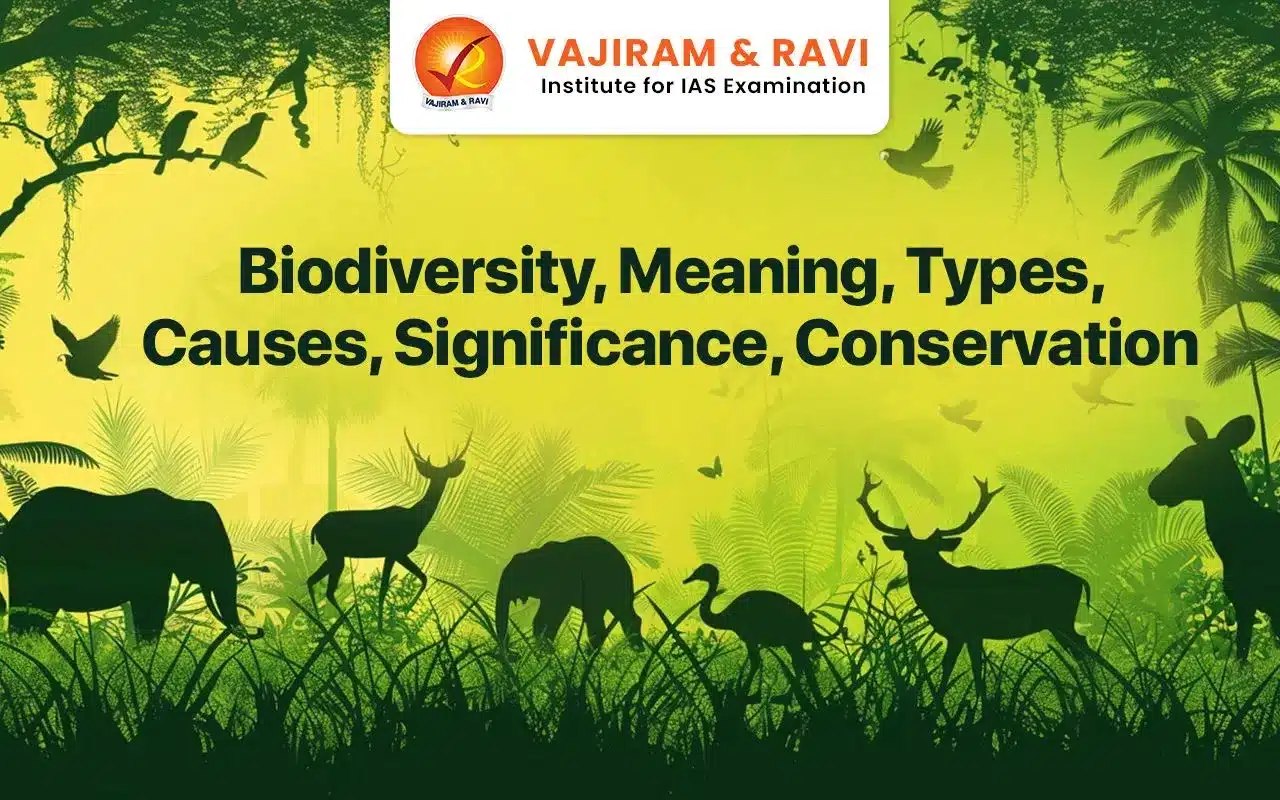Biological diversity or biodiversity is that part of nature that includes the variety of genes among the individuals of a species, the variety and richness of all the plant and animal species in an ecosystem and various types of ecosystems on the earth. It has been estimated that only around 1.75 million species out of the potential 8.7 million species of all the plants and animals have been identified and described so far, the majority of which are insects.
The biodiversity of a region is influenced by climatic factors as well as human interventions. The diversity of life on earth is essential for the healthy functioning of ecosystems and it is biodiversity that boosts ecosystem productivity.
Status of biodiversity
Globally, approximately 1.75 million species have been documented and formally named to date, and there are good grounds for believing that several million more species exist but have yet to be discovered and described. This means that millions of organisms remain a complete mystery to us.
Patterns of Biodiversity
Species are not evenly distributed over the planet. Generally, species diversity declines as we move away from the equator towards the poles.
- Biodiversity-rich ecosystems: Tropical forests, extending over around 7% of the world's surface hold up to 90% of the world's species. The Amazon rainforest in South America has the greatest biodiversity on earth and Brazil has the highest biodiversity index among all the 17 megadiverse countries.
- Altitude: Altitude mimics the latitude regarding the pattern of biodiversity.
- For example, in the Himalayas, the maximum biodiversity occurs at its foothills and it decreases when we move upwards on the slope.
- Causes for Tropical regions to have greater biological diversity: There are various hypotheses regarding the highest biodiversity in the tropical region.
- Greater Speciation: Speciation is a function of time. Unlike temperate regions which have been subjected to frequent glaciations in the past, tropical regions have remained relatively undisturbed for millions of years and thus, have a long evolutionary time for species diversification
- Constant climate with no/less season: Tropical environments are less seasonal, unlike temperate ones. It is relatively more constant and predictable. Such environments promote niche specialisation and lead to a higher species diversity.
- Higher insolation: There is more solar insolation in the tropics, which contributes to higher productivity and, consequently, greater diversity.
Biodiversity in India
India is one of the 17 world's recognised mega-diverse countries, home to roughly 7-8% of all documented species and four of the 36 globally defined biodiversity hotspots.
- India’s rich biodiversity: Because of the varying edaphic, climatic, and topographic conditions as well as years of geological stability, a diverse range of ecosystems and habitats have emerged in India including forests, grasslands, wetlands, deserts, and coastal and marine ecosystems.
- Flora and fauna: Over 1,03,258 species of fauna and 55,048 species of flora have been documented in the 10 biogeographic zones of the country.
- India has 28,948 endemic species of fauna, while 12,095 known plant species are endemic.
- Wetland ecosystem: India has a variety of wetland ecosystems ranging from high-altitude cold desert wetlands to hot and humid wetlands in coastal zones with diverse flora and fauna.
- About 4,445 km2 of the country is under mangroves.
- India is blessed with rich fish diversity with a current distribution of 783 species of freshwater fishes which includes 223 endemic fishes.
- India currently has 80 Ramsar Sites.
- Forest cover: 23.39% of the geographical area of the country is under forest cover with 16 major forest types and 251 sub-types.
Levels of Biodiversity
Biodiversity can be observed at three levels: genetic, species and ecosystem. These levels work together to create the overall complexity of life on Earth.
| Genetic diversity |
- It is the variety of genes within a species. A single species may demonstrate great variation at the genetic level across its distributional range. - For example: India has more than 50,000 genetically different strains of rice and 1,000 varieties of mango. - Genetic variability in animal or plant species is crucial for a healthy breeding population. Reducing the number of breeding individuals can lead to in-breeding, which can eventually lead to species extinction. |
| Species Diversity |
- It refers to the variety of plant and animal species in a region, varying in both natural and agricultural ecosystems, with some areas being more abundant. - For example: The Western Ghats have a greater amphibian species diversity than the Eastern Ghats. |
| Ecosystem diversity |
- It is the variety of ecosystems in a given region. - There are many different ecosystems on the planet, each with its own set of distinct interconnected species based on environmental characteristics. - For example: India, with its deserts, rain forests, mangroves, coral reefs, wetlands, estuaries, and alpine meadows, has higher ecological diversity than a Scandinavian country like Norway. |
Measurement of Biodiversity
Several frameworks use a variety of criteria to assess the state of biodiversity in a certain ecosystem. They explain how to assess biodiversity loss, positive impact, and associated hazards. Here are some of the prominent units of measurement that feed into these metrics:
- Species richness is a simple measure that quantifies the number of different species in a given ecosystem. It provides an overview of the number of species present. It has three components:
- Alphadiversity: It showsthe richness and evenness of individuals within an ecosystem.
- Betadiversity: Also called species turnover, it is an expression of diversity between ecosystems.
- Gammadiversity: It is a measure of the overall diversity of the different ecosystems within a landscape or region.
- Species abundance: It assesses the population numbers of various species in an ecosystem.
- Species evenness: It evaluates the distribution of individuals amongst different species within an ecosystem and assesses the relative proportions or balance of abundance among the species present.
- Ecosystem integrity: It focuses on the overall health, functioning, and resilience of an ecosystem. It is a measure of the system's ability to maintain its structure, processes, and biodiversity while being able to withstand and recover from disturbances or environmental changes.
Significance of Biodiversity
Biodiversity is essential to the existence of life on Earth. Greater biodiversity is beneficial not merely for the ecosystem but also for human well-being.
- Climate Change Resistance: Climate change and biodiversity loss are inextricably linked. Many species can only withstand certain climate conditions, and few can adapt quickly enough to keep up with the rapid pace of climate change. Greater biodiversity can preserve some natural habitats.
- Makes a resilient ecosystem: Higher biodiversity makes the ecosystem more complex.
- In this way, it is more resilient to occasional disturbances (natural or man-made), and resistant to invasions by alien species.
- Increased diversity contributes to higher productivity of the ecosystem.
- Economic productivity: Biodiversity increases ecosystem production because each species has a vital function to perform. More than half of global GDP is dependent on nature. More than 1 billion people depend on forests for their livelihood.
- For example: A larger number of plant species means a greater variety of crops, greater species diversity ensures natural sustainability for all life forms, and biodiversity provides humans with raw materials for consumption and production.
- Many livelihoods, such as those of farmers, fishers, and timber workers, are dependent on biodiversity.
- Biomimicry and bioprospecting: It is the emulation of natural systems and models, to solve complex human problems.
- Scientists have been studying nature to understand how species work, produce, and consume resources, aiming to replicate the remarkable feats that millions of years of evolution have produced. Biodiversity is being leveraged for economic development using biomimicry.
- The biotechnologist uses biodiverse places to 'prospect' and look for prospective genetic traits in plants or animals that can be utilised to generate better crop types for farming and plantation programmes, as well as better livestock.
- Example: Some spiders can produce their silk (made of proteins) with a higher tensile strength than many alloys of steel.
- Ecosystem services: Biodiversity supports functioning ecosystems that offer oxygen, clean air and water, plant pollination, pest control, wastewater treatment, and a variety of other ecosystem services.
- Social values: Biodiversity's value is crucial in the livelihood of traditional communities and cultural, recreational and aesthetic sentiments for the general public.
Conservation of Biodiversity
According to WWF’s Living Planet Report 2020,the world has seen an average 68% drop in mammal, bird, fish, reptile, and amphibian populations since 1970. Following are the threats to biodiversity.
- Habitat loss and fragmentation: This is the primary cause of animal and plant extinction. The degradation of many habitats by pollution also threatens the survival of many species.
- Example: Tropical rain forests once covering more than 14 percent of the earth’s land surface, now cover no more than 6 percent.
- The Amazon rainforest, home to millions of species, is being cut down for soya bean cultivation or for conversion to grasslands for raising beef cattle.
- Example: Tropical rain forests once covering more than 14 percent of the earth’s land surface, now cover no more than 6 percent.
- Overexploitation: Human overuse and misuse of natural ecosystems have led to the conversion of once-productive forests and grasslands into deserts and wastelands.
- Example: Mangroves have been cleared for fuelwood and prawn farming, which has led to a decrease in the habitat essential for the breeding of marine fish.
- Invasive Alien Species: When alien species are introduced mistakenly or deliberately for whatever reason, some become invasive and cause the decline or extinction of native species of the ecosystem.
- Threats posed to the native species of India by invasive weed species like Lantana, water hyacinth, Carrot grass, Eucalyptus, etc.
- Co-extinctions: When a species becomes extinct, all of the plant and animal species that are obligately connected with it also become extinct.
- Example: When a host fish species goes extinct, so does its unique array of parasites.
- Climate change: Climate change causes devastating effects on the biodiversity of the world.
- For example: Melting ice is cutting off polar bears' access to critical food sources and warming waters contribute to the disappearance of coral reefs.
Conservation Efforts
Both In-situ and Ex-situ conservation efforts are practised to conserve biodiversity.
- In-situ conservation:
- In-situ conservation efforts include protection of ‘Protected Areas’ such as Biosphere reserves, National parks and wildlife sanctuaries, biodiversity hotspots, and Sacred groves and the biodiversity in these protected areas.
- These efforts are sometimes focused on a particular species such as Project Tiger, Project Hangul, etc.
- Another means to conserve biodiversity is the identification of hotspots. It must have at least 1,500 vascular plants as endemics and it must have 30% or less of its original natural vegetation remaining, thus it must be threatened.
- There are 36 such hotspots across the world, including 4 in India.
- Himalaya, Indo-Burma, Western Ghats, and Sri Lanka, Sundaland are the biodiversity hotspots in India.
- India has 18 biosphere reserves, 106 national parks, 567 wildlife sanctuaries, 55 tiger reserves, and 31 marine protected areas.
- Ex-situ conservation: In this approach, threatened animals and plants are taken out of their natural habitat and placed in special settings where they can be protected and given special care.
- Ex-situ conservation efforts include zoological parks, botanical gardens, wildlife safari parks, etc.
Biodiversity UPSC PYQs
Question 1: The most important strategy for the conservation of biodiversity together with traditional human life is the establishment of (UPSC Prelims 2014)
- biosphere reserves
- botanical gardens
- national parks
- wildlife sanctuaries
Answer: (a)
Last updated on November, 2025
→ Check out the latest UPSC Syllabus 2026 here.
→ Join Vajiram & Ravi’s Interview Guidance Programme for expert help to crack your final UPSC stage.
→ UPSC Mains Result 2025 is now out.
→ UPSC Notification 2026 is scheduled to be released on January 14, 2026.
→ UPSC Calendar 2026 is released on 15th May, 2025.
→ The UPSC Vacancy 2025 were released 1129, out of which 979 were for UPSC CSE and remaining 150 are for UPSC IFoS.
→ UPSC Prelims 2026 will be conducted on 24th May, 2026 & UPSC Mains 2026 will be conducted on 21st August 2026.
→ The UPSC Selection Process is of 3 stages-Prelims, Mains and Interview.
→ UPSC Result 2024 is released with latest UPSC Marksheet 2024. Check Now!
→ UPSC Prelims Result 2025 is out now for the CSE held on 25 May 2025.
→ UPSC Toppers List 2024 is released now. Shakti Dubey is UPSC AIR 1 2024 Topper.
→ UPSC Prelims Question Paper 2025 and Unofficial Prelims Answer Key 2025 are available now.
→ UPSC Mains Question Paper 2025 is out for Essay, GS 1, 2, 3 & GS 4.
→ UPSC Mains Indian Language Question Paper 2025 is now out.
→ UPSC Mains Optional Question Paper 2025 is now out.
→ Also check Best IAS Coaching in Delhi
Biodiversity FAQs
Q1. What is Biodiversity?+
Q2. Why is biodiversity important?+
Q3. Why is biodiversity important?+
Q4. What are the three levels of biodiversity?+
Tags: biodiversity quest

















